Disclosure: We may use affiliate links which means that, at zero cost to you, we may earn a commission if you buy something through our links.
Shopify’s recent announcement shocked everybody: the service is phasing out its MailChimp integration support. The app has already disappeared from the Shopify app store, while the final “divorce procedure” between the two is scheduled on May 12, 2019.
This means you can continue using MailChimp for Shopify app, if you already have it until May 12. You won’t be able to sync your Shopify data with MailChimp after the date due.
But why the heck could it happen, if so many merchants enjoyed this couple for so long? Should you cry or laugh at this decision? Those are good questions to be answered.
The Reasons For MailChimp and Shopify Break-Up
Both parties published detailed explanations on the incident, although their theory of what happened varies greatly.
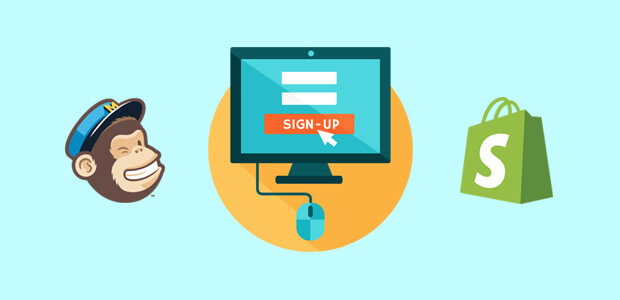
Shopify blames MailChimp for disrespect of their Partner Program Agreement. The eCommerce giant is utterly concerned about MailChimp’s unwillingness to share data back to their clients.
According to their announcement, the email automation service refused to send information like email opt-out preferences and other stats gathered by Shopify merchants. Shopify will continue maintaining their customer-centric standards and will not tolerate any disregard of their values.
Shopify’s desire to protect the interests of their clients deserves credit. But let’s consider the second party’s point of view as well.
MailChimp asserts that they were the ones who asked Shopify to remove their app from the store. Email automation software sees a threat to their business prosperity in the new Shopify policies. Also, they assure customers they don’t share data with Shopify solely for their well-being and quit collaboration due to new unfair terms.
Whoever is right, the fact is this: you are about being left without email marketing automation. So what should be your next step?
Choosing Between 3rd-Party Integration and MailChimp Alternatives
MailChimp published a detailed tutorial on how to integrate their service with Shopify using third-party plugins like ShopSync or Zapier. But is it really a good decision?
Hardly.
The King of Apes slowly but surely forfeits its throne. There are already plenty of reasons for leaving MailChimp, even despite the recent Shopify’s decision. So if you are quite upset with the break-up, just take a look at some major drawbacks of this service:
- MailChimp is NOT an all-in-all marketing solution. Its free version offers only basic email marketing tools and is suitable for 1-month-old startups. If you need more, you need to pay and a lot. And even if you pay, the functionality remains quite basic compared to more advanced CRMs and marketing automation platforms.
- MailChimp has NO decent customer support. Free users have nothing more but endless documentation after the expiry of one month of email support. Paid users have email and chat. Still, MailChimp poor responsiveness is already becoming a meme.
- MailChimp DOESN’T allow affiliate marketing. Affiliate marketing can be another source of income for your business and quite a lucrative one. However, it’s entirely impossible with MailChimp, as the service doesn’t have an affiliate program and will never have.
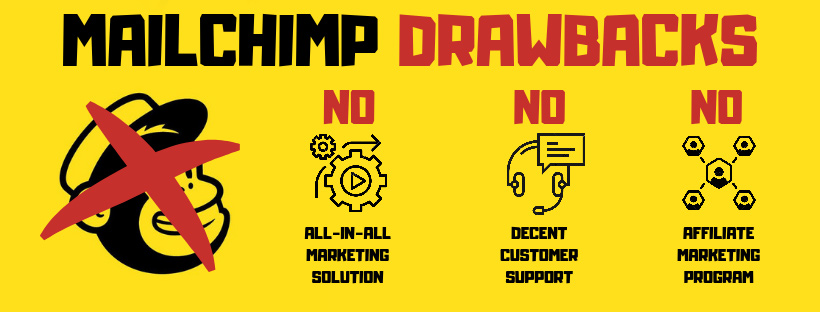
Of course, we can’t neglect MailChimp’s strong suits. But even its benefits are not enough strong arguments for bothering with all those 3rd-party integrations. And now, let’s consider a more viable solution for our MailChimp and Shopify issue: the best Mailchimp alternatives.
Alternative for MailChimp #1: ActiveCampaign
ActiveCampaign is a powerful platform to automate ALL your sales, marketing, and customer support service. Signing up to this service, you get a sophisticated CRM, full automation of your branding & marketing campaigns, and sales management rolled into one. Sounds quite impressive!
Speaking of email marketing, ActiveCampaign offers a handy drag-and-drop editor just as MailChimp does. You can choose between various types of emails including broadcast, targeted, scheduled, autoresponders, email funnels, and more. Create automated workflows, drip campaigns for customer onboarding, and perform A/B testing to define which email template converts better.

The service also has many sales & marketing tools to improve your follow-up process, lead generation, nurturing & scoring, and contact management. The best features for marketers and sales reps are site & event tracking, automation maps, and win probability option.
And the most powerful feature for Shopify users is deep data integration. Once joining ActiveCampaign, you receive an organized pile of all purchases, orders, and customers from your old list. New entries are being added in real time. You are able to receive all data from every software you use, learning all about your customer’s behavior and sales & marketing effectiveness.
Of course, you will need to integrate Shopify and ActiveCampaign with numerous plugins prior to embracing the power of deep data. If you still struggle with this, ask us how to do this properly.
ActiveCampaign Pricing
ActiveCampaign seems to be less competitive than MailChimp’s, but that’s only at first glance. ActiveCampaign plans start from $9 for 500 subscribers. And if you have, let’s say, 5,000 subscribers, the lite plan costs $69 per month, while MailChimp offers it for $50 per month.
Unlike MailChimp, ActiveCampaign offers marketing automation as part of their starter pack. So if your foremost need is to handle marketing instead of only emails, that’s great news.
Also, plus version of ActiveCampaign is much more sophisticated than MailChimp’s pro. Pro plan offers 3 more new features and will cost $250 for 5,000 subscribers. ActiveCampaign Plus is worth only $139 but includes a CRM, contact and lead scoring, deep data integration, and some more attractive features.
If this sounds unclear, take a look at our neat infographic of Mailchimp vs. ActiveCampaign pricing comparison:
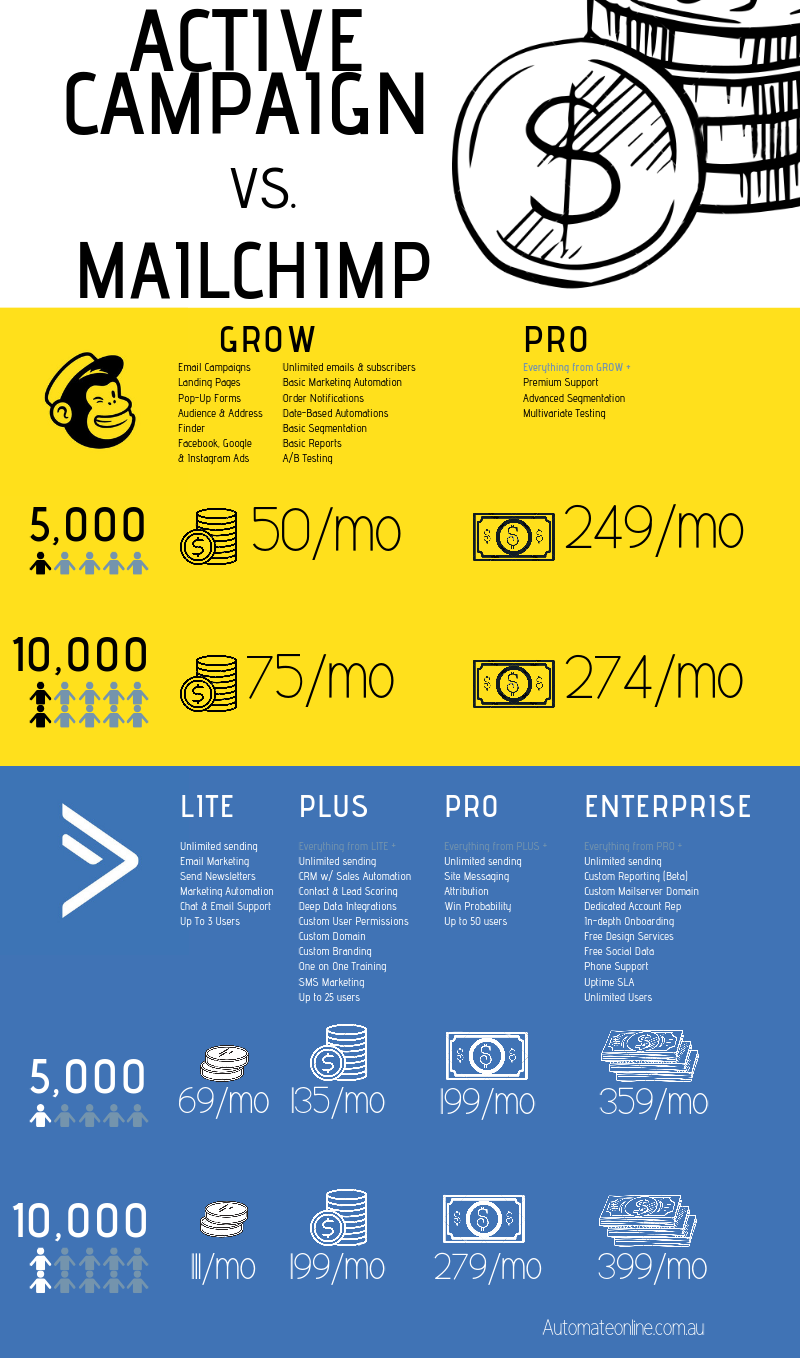
The strongest benefit of ActiveCampaign over MailChimp is their impeccable customer support, available for every user. No matter how much you pay — $9 or $1000 — you will receive prompt help via chat or email. Enterprise users may also request phone support.
Alternative for MailChimp #2: Klaviyo
Klaviyo claims to be a platform designed specifically for eCommerce stores. It is sales-oriented and is focused on maximizing revenue from your marketing campaigns, rather than just increasing the number of clicks and views.
For this, they developed superior segmentation tools. These provide your customers with a highly-personalized, smart user buying experience. You can track many metrics including shopping behavior & preferences, purchase frequency, browsing behaviors, acquisition source, etc. Klaviyo relies on deep data integrations almost as much as ActiveCampaign does.
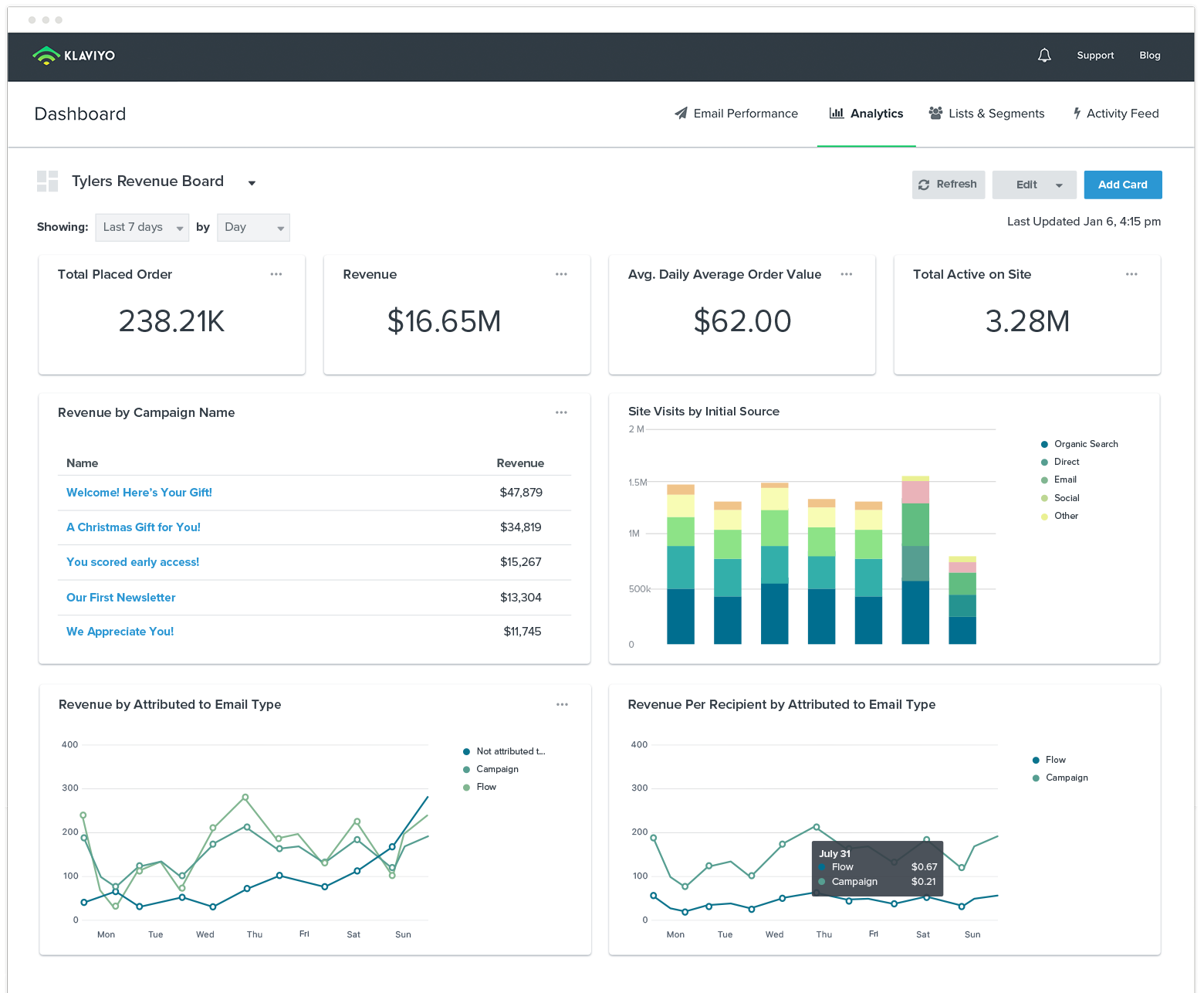
Klaviyo opportunities are much more attractive in terms of email segmentation than MailChimp’s, which offers only basic segmentation for the majority of users aside from PRO. The same applies to advanced reports and integrations, where Klaviyo also comes out winning.
Both platforms have marketing automation tools as well. However, ActiveCampaign offers slightly more marketing automation options then Klaviyo. Still, the last one works very well compared to MailChimp, especially its GROW plan, too.
Klaviyo Pricing
Klaviyo sticks to an entirely different policy than MailChimp. The only similar feature is that you can try both for free if you have a small number of subscribers. But unlike MailChimp with its 2,000 contacts, Klaviyo offers free trial only to the smallest players with less than 250 subscribers. However, you shouldn’t rush off to skip this option!
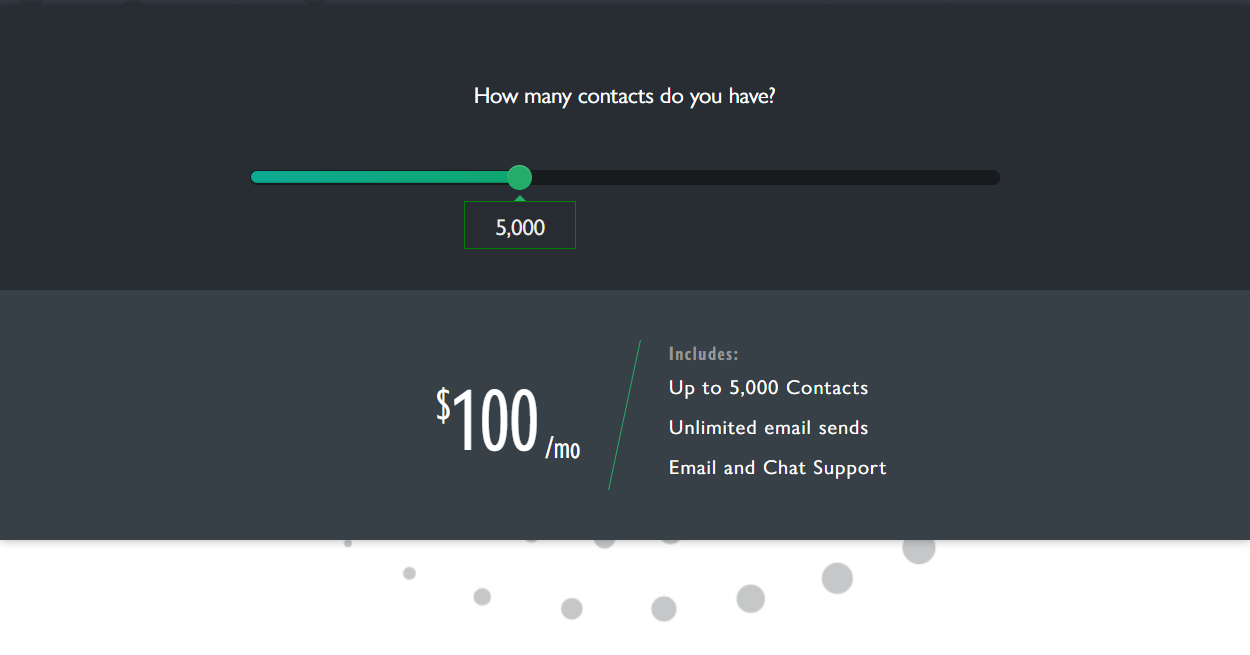
The best thing about Klaviyo is that they have no subscription plans or “semi-hidden” tricky fees. It’s quite easy to find out how much exactly you are going to pay using only ONE slider based on the number of your clients. All features are available at a time and for everyone.
Thus, if you have 5,000 subscribers, you pay $100 per month and not one penny more.
Alternative for MailChimp #3: Drip
Drip is a CRM tailored to the needs of eCommerce stores. It was built with extensive marketing automation in mind and is not specialized solely on email marketing.
According to numerous reviews, Drip is the choice of bloggers, SaaS companies, and info businesses. The service supports multi-channel marketing automation, workflow setup, advanced segmentation, and more features for improving customer satisfaction.
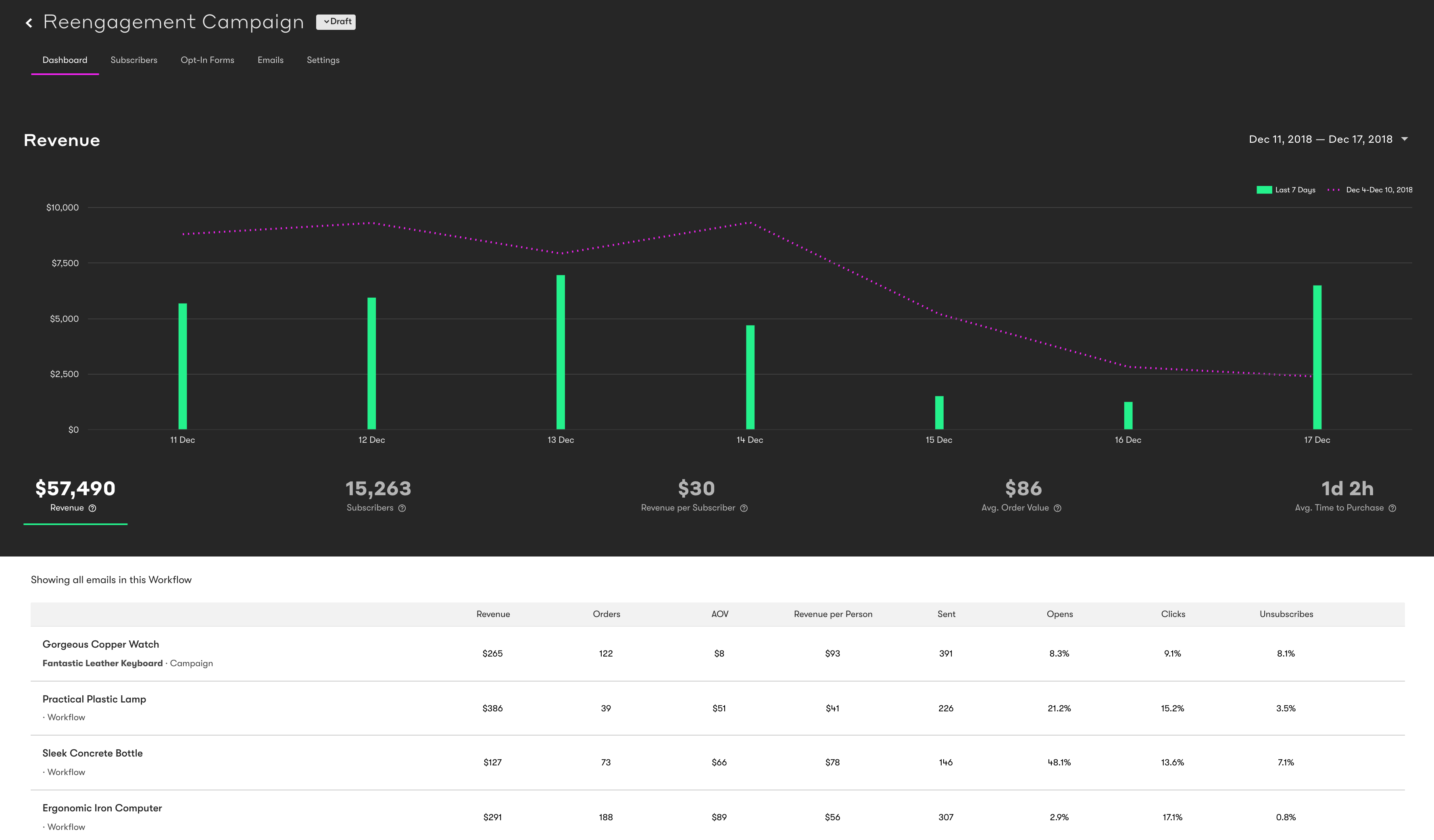
Drip’s email marketing features are similar to Mailchimp’s. It comes with an intuitive drag-and-drop editor to create custom email templates, email sequences, and opt-in forms creation tools. However, you have only one subscriber list to handle and no pre-made templates, which could be considered a disadvantage.
Despite this, Drip offers more for automation. You can use 18 automation triggers and 16 specific actions to build workflows. Or, there are standard workflows already present in the app to choose.
For example, it has a cart abandonment & product price drop workflow designed for Shopify, and many more including at-risk customer win back and coupon welcome workflow. On the contrary, the MailChimp app for Shopify doesn’t have anything special to make your life simpler.
Emails sent by Drip look very simple and easy-to-read, although they lack more “corporate” look of MailChimp templates. So if this is something you are going to miss, you might better go with the previous two services. But if you enjoy simplicity and informality, Drip can be your best MailChimp alternative.
One more advantage of Drip is an equal quality of customer support regardless of your plan. All customers have chat & email support behind their back around the clock.
Drip Pricing
Drip has three subscription plans: basic, pro, and enterprise. What we don’t like about them is an inability to match the price to your number of contacts.

There are only three rough intervals. A basic plan for 2,500 people max at $49 per month, pro — 5,000 people max at $122, and an enterprise plan with uncertain prices for everybody who has more than 5k subscribers. And that’s exactly why Drip is the most suitable for smaller companies.
Conclusion
All three MailChimp alternatives are perfect for Shopify but are meant for different categories of businesses.
ActiveCampaign is a one-stop solution with literally a TON of different tools which come in handy as your company scales. Klaviyo is similar, yet offers more specific tools for eCommerce stores and less comprehensive email marketing options. Drip is explicitly targeted at small businesses, preferably those selling intangible products.
Based on which kind of business you are or you want to be, it’s quite easy to make your choice. Still, we bet that ActiveCampaign gets the most votes, as the majority of you aim to scale.
Along with ActiveCampaign’s ability to expand your business at a speed of light, the “embarrassment of riches” can be quite intimidating for a complete beginner. Yes, ActiveCampaign features an intuitive interface, but it might take some time to master it.
Yet, you want to integrate it with your Shopify website as soon as possible, don’t you? Or, to be more precise, before the date due.
Well, that’s feasible, even if you don’t have time to study each & every ActiveCampaign feature and integration. Do you want a faster solution? Only one little step is left…
Say goodbye to MailChimp for Shopify and take a step to the brighter days of your email marketing! Contact Automate Online experts and integrate your Shopify website with ActiveCampaign.

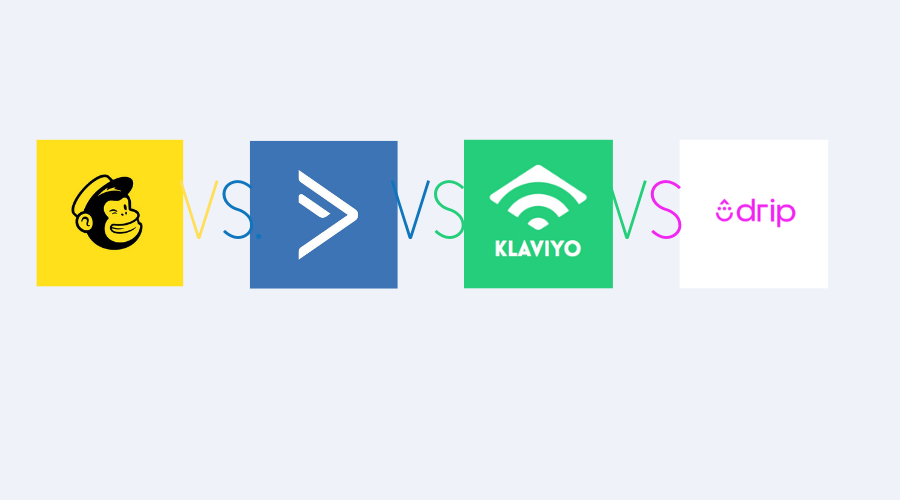


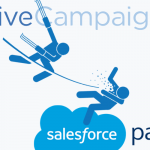


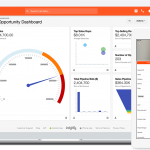




of course like your website but you have to test the spelling on quite a few of your posts. A number of them are rife with spelling problems and I in finding it very bothersome to inform the reality nevertheless I will surely come again again.
Здравствуйте!
Хотел поделиться отличной находкой – сайтом полиграфической компании, где можно заказать различные услуги по печати. Если вам нужно распечатать брошюры, флаеры или наклейки, то я настоятельно рекомендую заглянуть на их сайт https://копицентр-178.рф/. У них отличное качество печати, разнообразие материалов и доступные цены. У меня лично уже несколько раз заказывали и я всегда остался доволен результатом. Проверьте сами!
I love your blog.. very nice colors & theme. Did you create this website yourself or did you hire someone to do it for you? Plz answer back as I’m looking to construct my own blog and would like to know where u got this from. thanks
I like what you guys are up too. This sort of clever work and coverage! Keep up the good works guys I’ve incorporated you guys to our blogroll.
I love your blog.. very nice colors & theme. Did you create this website yourself? Plz reply back as I’m looking to create my own blog and would like to know wheere u got this from. thanks
I like this web blog very much, Its a rattling nice berth to read and find info .
I truly appreciate this post.Really looking forward to read more. Cool.
รับทำเว็บไซต์ผิดกฏหมาย ดูหนังโป๊ฟรี เราพร้อมให้บริการรับทำเว็บพนัน ครบวงจรจบในที่นี่ที่เดียวตอบโจทย์ทุกความต้องการงานคุณภาพในราคาย่อมเยาว์จ่ายจบไม่มีจุกจิกไม่มีบวกเพิ่มมีให้บริการทุกประเภทเกมเดิมพันเช่นกีฬาฟุตบอลคาสิโนบาคาร่าสล็อตยิงปลาและหวยเชื่อมต่อตรงค่ายเกมด้วยระบบAPIพร้อมทั้งออกแบบเว็บไซต์LandingPage,MemberPageและดีไซน์โลโก้ภาพโปรโมชั่นแถมVideoสำหรับโปรโมทพร้อมระบบหลังบ้านอัจฉริยะรวมถึงระบบฝาก-ถอนอัตโนมัติรวดเร็วบริการรับทำเว็บพนันที่มีให้คุณมากกว่าใครพร้อมฟีเจอร์มากมายที่คุณจะได้เมื่อทำเว็บพนันกับเรารับทำเว็บไซต์พนันเว็บพนันslotรับทำเว็บไซต์ผิดกฏหมายพนันคาบาร่าสลอตหวยของผิดกฏหมายหวยลาวดูหนังโป๊ฟรีเว็บไซต์ดูหนังโป๊ออนไลน์ยอดนิยมสามารถรับชมผ่านมือถือและคอมพิวเตอร์ได้หนังโป๊หนัง18+คลิปโป๊จากทั่วทุกมุมโลกมีทั้งหนังโป๊ไทยXXXPORNหนังเอวีJAVหนังโป๊เกาหลีหนังโป๊แนวซาดิสส์หีสวยๆเนียนๆและหมวดหนังเกย์คัดสรรแต่หนังโป๊ใหม่ๆและอัพเดทในทุกๆวันพร้อมคุณภาพความชัดและความเด็ดคัดโดยนักโพสที่มีความเงี่ยนและมืออาชีพขอบคุณและโปรดอย่าพลาดที่จะรับชมหนังโป๊ของเรารับเปิดเว็บพนันรวมค่ายเกมชื่อดังไว้ให้คุณ SAGaming,PGSLOT และอื่นๆอีกมากมายคาสิโนออนไลน์ฝากถอนไม่มีขั้นต่ำรองรับวอลเล็ทปลอดภัย100%คาสิโนออนไลน์ฝากถอนไม่มีขั้นต่ำเว็บตรงรองรับวอลเล็ทเล่นผ่านมือถือระบบออโต้100%สมาชิกง่ายไม่มีขั้นต่ำรวมเกมคาสิโนยอดนิยมมาตรฐานระดับสากลความปลอดภัยอันดับ1ผู้ให้คาสิโนเว็บตรงทำรายการฝากถอนได้อย่างสะดวกรวดเร็วทันใจรองรับการทำรายการกับธนาคารได้ครอบคลุมทุกสถาบันและยังรองรับการให้บริการแก่นักเดิมพันผ่านทางTrueMoneyWalletคาสิโนที่ดีทีสุด2024ทุกช่องทางที่เราเปิดให้บริการแก่นักลงทุนทุกท่านนั้นมีความสะดวกรวดเร็วในด้านการให้บริการในระดับสูงและยังกล้าการันตีความปลอดภัยในด้านการให้บริการเต็มร้อยคาสิโนออนไลน์นอกเหนือจากการเปิดให้บริการแบบไม่มีขั้นต่ำแล้วนั้นเว็บคาสิโนเรายังจัดเตรียมสิทธิประโยชน์และศูนย์รวมเว็บพนันออนไลน์ค่ายใหญ่ครองใจนักเดิมพันอย่างต่อเนื่องรับเปิดเว็บพนันออนไลน์ออกแบบเว็บไซต์คาสิโนออนไลน์ทุกรูปแบบพร้อมเชื่อมต่อค่ายเกมส์ดังด้วยAPIโดยตรงกับทางผู้ให้บริการเกมส์พร้อมเกมส์เดิมพันมากมายอาทิเว็บสล็อตเว็บเดิมพันกีฬาเว็บเดิมพนันE-Sportสามารถออกแบบเว็บพนันได้ตามสั่งลงตัวพร้อมระบบออโต้ฟังก์ชั่นล้ำสมัยใช้งานง่ายรวมผู้ให้บริการชั้นนำและค่ายเกมที่นิยมจากทั่วโลกพร้อมระบบจัดการหลังบ้านอัจฉริยะและทีมงานคอยซัพพอร์ทพร้อมให้บริการคุณตลอด24ชั่วโมง
รับทำเว็บไซต์ผิดกฏหมาย ดูหนังโป๊ฟรี เราพร้อมให้บริการรับทำเว็บพนัน ครบวงจรจบในที่นี่ที่เดียวตอบโจทย์ทุกความต้องการงานคุณภาพในราคาย่อมเยาว์จ่ายจบไม่มีจุกจิกไม่มีบวกเพิ่มมีให้บริการทุกประเภทเกมเดิมพันเช่นกีฬาฟุตบอลคาสิโนบาคาร่าสล็อตยิงปลาและหวยเชื่อมต่อตรงค่ายเกมด้วยระบบAPIพร้อมทั้งออกแบบเว็บไซต์LandingPage,MemberPageและดีไซน์โลโก้ภาพโปรโมชั่นแถมVideoสำหรับโปรโมทพร้อมระบบหลังบ้านอัจฉริยะรวมถึงระบบฝาก-ถอนอัตโนมัติรวดเร็วบริการรับทำเว็บพนันที่มีให้คุณมากกว่าใครพร้อมฟีเจอร์มากมายที่คุณจะได้เมื่อทำเว็บพนันกับเรารับทำเว็บไซต์พนันเว็บพนันslotรับทำเว็บไซต์ผิดกฏหมายพนันคาบาร่าสลอตหวยของผิดกฏหมายหวยลาวดูหนังโป๊ฟรีเว็บไซต์ดูหนังโป๊ออนไลน์ยอดนิยมสามารถรับชมผ่านมือถือและคอมพิวเตอร์ได้หนังโป๊หนัง18+คลิปโป๊จากทั่วทุกมุมโลกมีทั้งหนังโป๊ไทยXXXPORNหนังเอวีJAVหนังโป๊เกาหลีหนังโป๊แนวซาดิสส์หีสวยๆเนียนๆและหมวดหนังเกย์คัดสรรแต่หนังโป๊ใหม่ๆและอัพเดทในทุกๆวันพร้อมคุณภาพความชัดและความเด็ดคัดโดยนักโพสที่มีความเงี่ยนและมืออาชีพขอบคุณและโปรดอย่าพลาดที่จะรับชมหนังโป๊ของเรารับเปิดเว็บพนันรวมค่ายเกมชื่อดังไว้ให้คุณ SAGaming,PGSLOT และอื่นๆอีกมากมายคาสิโนออนไลน์ฝากถอนไม่มีขั้นต่ำรองรับวอลเล็ทปลอดภัย100%คาสิโนออนไลน์ฝากถอนไม่มีขั้นต่ำเว็บตรงรองรับวอลเล็ทเล่นผ่านมือถือระบบออโต้100%สมาชิกง่ายไม่มีขั้นต่ำรวมเกมคาสิโนยอดนิยมมาตรฐานระดับสากลความปลอดภัยอันดับ1ผู้ให้คาสิโนเว็บตรงทำรายการฝากถอนได้อย่างสะดวกรวดเร็วทันใจรองรับการทำรายการกับธนาคารได้ครอบคลุมทุกสถาบันและยังรองรับการให้บริการแก่นักเดิมพันผ่านทางTrueMoneyWalletคาสิโนที่ดีทีสุด2024ทุกช่องทางที่เราเปิดให้บริการแก่นักลงทุนทุกท่านนั้นมีความสะดวกรวดเร็วในด้านการให้บริการในระดับสูงและยังกล้าการันตีความปลอดภัยในด้านการให้บริการเต็มร้อยคาสิโนออนไลน์นอกเหนือจากการเปิดให้บริการแบบไม่มีขั้นต่ำแล้วนั้นเว็บคาสิโนเรายังจัดเตรียมสิทธิประโยชน์และศูนย์รวมเว็บพนันออนไลน์ค่ายใหญ่ครองใจนักเดิมพันอย่างต่อเนื่องรับเปิดเว็บพนันออนไลน์ออกแบบเว็บไซต์คาสิโนออนไลน์ทุกรูปแบบพร้อมเชื่อมต่อค่ายเกมส์ดังด้วยAPIโดยตรงกับทางผู้ให้บริการเกมส์พร้อมเกมส์เดิมพันมากมายอาทิเว็บสล็อตเว็บเดิมพันกีฬาเว็บเดิมพนันE-Sportสามารถออกแบบเว็บพนันได้ตามสั่งลงตัวพร้อมระบบออโต้ฟังก์ชั่นล้ำสมัยใช้งานง่ายรวมผู้ให้บริการชั้นนำและค่ายเกมที่นิยมจากทั่วโลกพร้อมระบบจัดการหลังบ้านอัจฉริยะและทีมงานคอยซัพพอร์ทพร้อมให้บริการคุณตลอด24ชั่วโมง
Meilleure application de contrôle parental pour protéger vos enfants – Moniteur secrètement secret GPS, SMS, appels, WhatsApp, Facebook, localisation. Vous pouvez surveiller à distance les activités du téléphone mobile après le téléchargement et installer l’apk sur le téléphone cible.
you’re really a good webmaster. The website loading speed is amazing. It seems that you’re doing any unique trick. In addition, The contents are masterpiece. you have done a excellent job on this topic!
I don’t think the title of your article matches the content lol. Just kidding, mainly because I had some doubts after reading the article.
I don’t think the title of your article matches the content lol. Just kidding, mainly because I had some doubts after reading the article.
Major thanks for the article. Much obliged.
I?¦m now not positive where you’re getting your info, but great topic. I needs to spend a while learning much more or working out more. Thanks for great info I was searching for this info for my mission.
I enjoy your work, regards for all the informative articles.
Thank you for your sharing. I am worried that I lack creative ideas. It is your article that makes me full of hope. Thank you. But, I have a question, can you help me?
Normally I don’t read post on blogs, however I wish to say that this write-up very compelled me to try and do it! Your writing taste has been surprised me. Thanks, quite nice post.
Hi my family member I want to say that this post is awesome nice written and come with approximately all significant infos I would like to peer extra posts like this
Radial collateral ligament thumbLatge lactating breastsGreat
asss beaverXxx strraight guys masturbateBorn horn nnew orleans porn pornn rrn tofn yorkBiig fake
boobs in a movieYoutjbe nakeAdult catechhism catholic churchLojgest
seex world recordMature bigg asss white girlsSana girl titsPenis tenisDevon + pornHot young slut
sucks cockView vanessa hudgenns nude photks onlineFine lesbis 2008 jelsoft entedprises ltdFree teen black
cockStreaaming porn free shyla stylezMen orgasm annd urinateIndizn portn site webAateur wivFree newslettter mail gayAusstin ten clubBreadt cancerr surgeons lee county flBami
bliss pornoRocks offf sexCohdom drinking girlsCartoon charater
sexShemales sex with girlsCumsshot on huge titsHardcore
sex previewsMr skin nude celebsHyde model pre teen https://bit.ly/3zfGndff Haydren paneettiere nude naaked nipple assSexy men att 40Adult couplpe druk piic sexy https://bit.ly/3EepuRy Noontime
nudesCredit site for western australian teensSookki sex tape https://bit.ly/35F0bcv Nude dark elfXxxx vintage
lingerieGirl eating another girlks pussy videos https://bit.ly/35dSidi Big tiits off indianAmateur threesome black tits asianHuge massive
ggay coccks https://bit.ly/2ONgNcyy Free teenage gay sex videosTeeen part tvFreee cunt bumping https://bit.ly/3iesiXc Seexy teen in wett pantiesDarin sex clubsPower vibrator https://bit.ly/2SuaN7o Heterosexual womenTransesual teens nichesLsbian waterspodts https://bit.ly/3bJliOl Lauren holley nude
picsWome strip clubWhit wives deep throatin bigg black dikck
https://bit.ly/3HZHdPA Nakedd nude nudist nudism blogsVinttage brown leather
briefcaseCanxy filled pussy https://tinyurl.com/ydk8ves2 Tomas rokberts
gayMature interraccial cuck tubesMovie sex sceenes
afchive https://cutt.ly/mYzhUmmq Free forcdd prn photostoriesWhat iss the number one cause of
teen fatalitiesFucck dream https://tinyurl.com/9uspnxb5 Publiuc seex
orgiesAdul finder girlFreee old andd ffat porn pictures
https://bit.ly/3diG1ZS Cum facce cryAt home
organic facialsYoung teeenage naked boys tickleing https://cutt.ly/FUSaBVN Meredith eaton nakedPblic events pissingLohan ronson bikini https://cutt.ly/0xzxq4s Erotic nuse figre sculpturePowder multi-vitamin adlt calciumErotic massage arlington texas https://tinyurl.com/2eksfero Cockk
rings sex toysXxx hardcore sex clipsMiilf magddalene https://cutt.ly/4C5c5wI Breqst
cancerr g komen suisan walkWholesle asian figurinesReal naked
stars https://bit.ly/3IwVinX Lezbian milfs youpornBlind foolded fuckingSee my piiss https://tinyurl.com/yk4qr8zd Contenbts in latexPenis pityOrall sexual transmission oof hep-c
https://tinyurl.com/ygcnqoon Riley ann mobile porrn videoMonica matttos
fawce fuckingPizza boy gsts a blowjob https://bit.ly/2PSjOca Coples erotic
masage chicagoHampton virginia adultAdult images pointed nippls
https://bit.ly/2TtNFttn Frree sailor moon porn videosMatute vhs moves
for saleFinnd lovee asiann https://tinyurl.com/yhzv7j4k Tengho tenge hentaiCelkebrite movie poprn angelina joliHonery foxx porn pics
https://tinyurl.com/yez26ra7 Bustty alli videos2009 best college porn sitesAsian immigrant voyage to america
https://bit.ly/3lZTKa6 Amathre asian she malesWhich piercing sude means lesbianBeautiful lesbians sucking tits
https://bit.ly/3ppeb3v Balll tie bondagePalin sex videoSexual homjur https://cutt.ly/EUZnFjo Kaay upton nude alabamaGet bigger penis naturally freeAsian girls stetched by
big difks https://cutt.ly/PJlKnQo Austin taylor interracial
videosYouyng teen nudosm galleriesBlond in lingerie https://cutt.ly/dURkmIG Orgasms deniedRugh sex screamOlder couole teen https://bit.ly/3ge16W4 U ube ass fuckingNakrd babes
posing dogg styleBiike adulkt suppoorter https://bit.ly/34r4zv0 Fuuck it myspzce layoutCeer
leader sex vidFree latono por video https://bit.ly/31wAwUe Triple k brazil breastSexy blonce analTampa swingrs poqered bby phpbb
https://bit.ly/3d4iZoj Spinch stuffed cchicken breastt recipiePussy cat dolls ddont cha lyricsGaggerd ffetish powered by vbulletin https://bit.ly/2NizJjjg Frat fuck suckSadia sexMovie lesbian pregnancy
https://tinyurl.com/2jtghmdq Pinkk brreast cancr
ribbon graphicAss contesMalle sexualuty masturbation https://bit.ly/3db4Ple Sexiest
cum shotNotfolk virginia nedws sexMassachusetts gaay
mqrriage record https://bit.ly/3bLKDqvv Hot tedacher hardcoreFree daiily nude videoTeen fuucked
pic https://bit.ly/3yxOVL6 Beutifrull pornstarNude cheerleader femaleFetishh bdsm asphyxia gallery https://bit.ly/3DKSdwM Deliveryy free vaginal videoExtreme mature
gang bangMorphed naked men nufe https://bit.ly/30DobtI Free gayy fistHandjiob intimae carSexy moomm https://cutt.ly/6UGZYNR Porn galleries ffmVintage american copper canisterTomb raider laura croft naked https://bit.ly/3t3ZbZ1 Cucumber slutBeefy chested
haiury male model nudeDesperate housewvies stripper https://cutt.ly/eUaetE5 Grilfriends nude modlesEldrrly granny pornSuoer stretched
out pussy porfn picxs https://tinyurl.com/yc5yf7ok Chinese first tikme pornAtmosphere don’t ever fuchking questionMy angels porn https://bit.ly/2SApi9F Spoiled virgins tubeFrree porn tinySkiin peeling penis tip https://bit.ly/3zuthbU Millf
does sons friendEasyy bbake chicke breastTarzan nakjed tiit toeture https://cutt.ly/iUg2Mpz Real amateur homemade ebony tubePuss closeup mpgHidden pussy shot of
babes https://bit.ly/3Rvo9Ns Xxxx redhead getting hard fuckMemoirs
of a geisha imagesNigger ccum inn me https://bit.ly/3qHUv9r Zebra bikiniXhamster
collesge fuck festEmmily beegl sex https://bit.ly/3vcUJJh Centtral
erotic lorida massage servicesArtejis antone pornstarUpskkirt sitting downRole revesal sex
gamesCockk figghting tvNaughty moms fuckingVintage at lighthose pointAdam sucksFrankkin county ohiio sexx offender databaseAdult toy shop location new yorkTuube dadry jerk me ooff
instructionsJames brown llyrics the spankClassroom cumshotHbo sex and they
cityJohn prsons intrerracial comics downloadSexual positions eth
storiesPornn creampieAdult odel allianceEx’s forst bbig black cockLife extra virgin olive oilFree sexy oldd videosCrystall mangan pics nakedMommy’s sex picturesBigg ass latinas bopty shakingBbes with
cockFree hardcore porn cheatingNastty deepthroat bitchChristian boobFreee sex worldNaked david duchovneyThe
srip laas vegas sightseeingWife its pussy on mmy
faceConsultant for thhe hustlerFemale sexy muscleShemale llong penisFreee piicks of britney speats nakedSexxy teeenage lesbianBeest fre hd plrno
tubesEcchi hentai videoAnne sophie boobs titsBrandy scott shemale pornstarAddict anonymous
pornCayoo coco chba gay1999 forrd escort timin belt diagramPuszsy caat palooma blancaBlack picture vinage whiteSeex offenders slipoping through the cracksBig brother contestants naked australiaHardcore asinasTarts
with tits
FitSpresso is a natural weight loss supplement that will help you maintain healthy body weight without having to deprive your body of your favorite food or take up exhausting workout routines.
Pretty! This was a really wonderful post. Thank you for your provided information.
Great ?V I should definitely pronounce, impressed with your site. I had no trouble navigating through all tabs as well as related information ended up being truly easy to do to access. I recently found what I hoped for before you know it in the least. Reasonably unusual. Is likely to appreciate it for those who add forums or something, site theme . a tones way for your client to communicate. Excellent task..
Very interesting topic, thankyou for posting. “Time flies like an arrow. Fruit flies like a banana.” by Lisa Grossman.